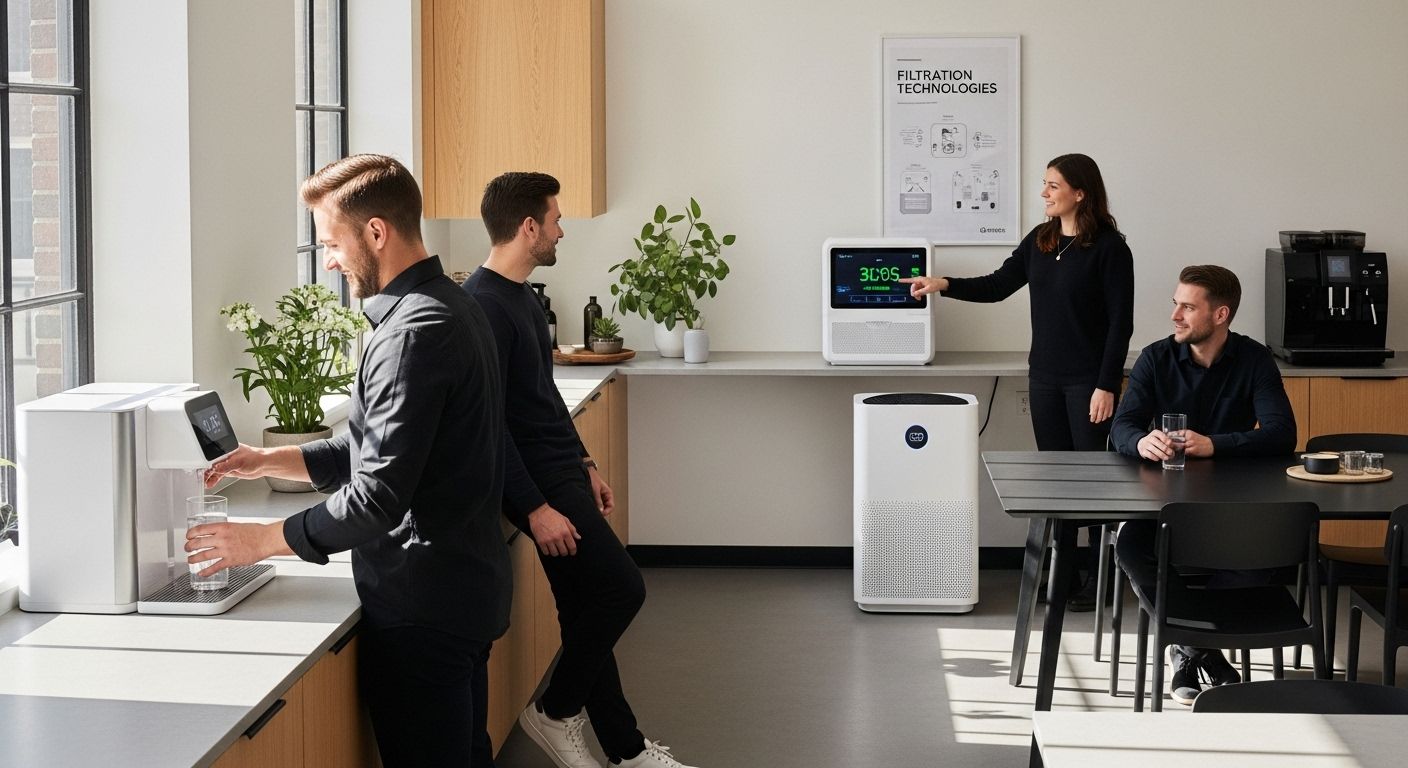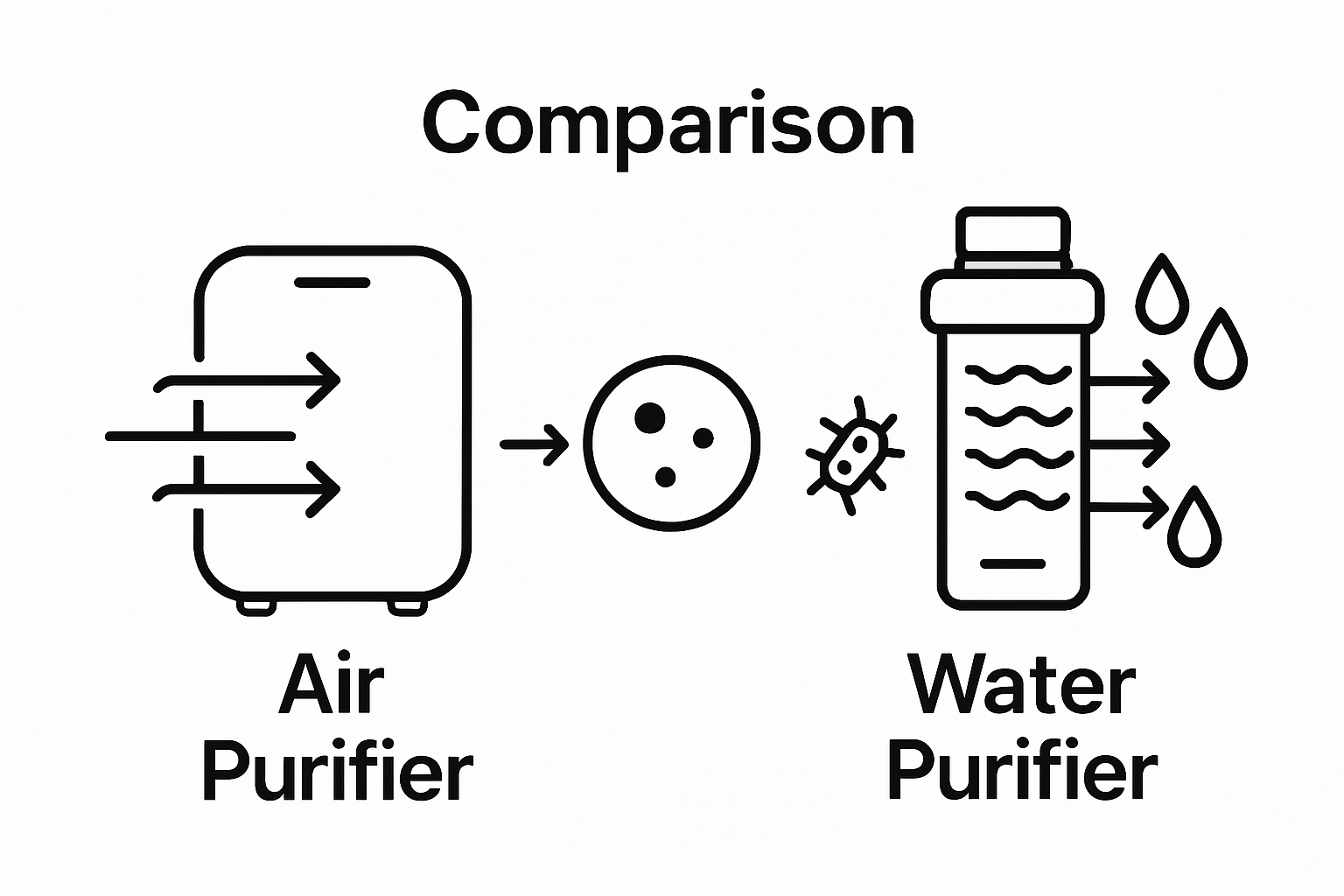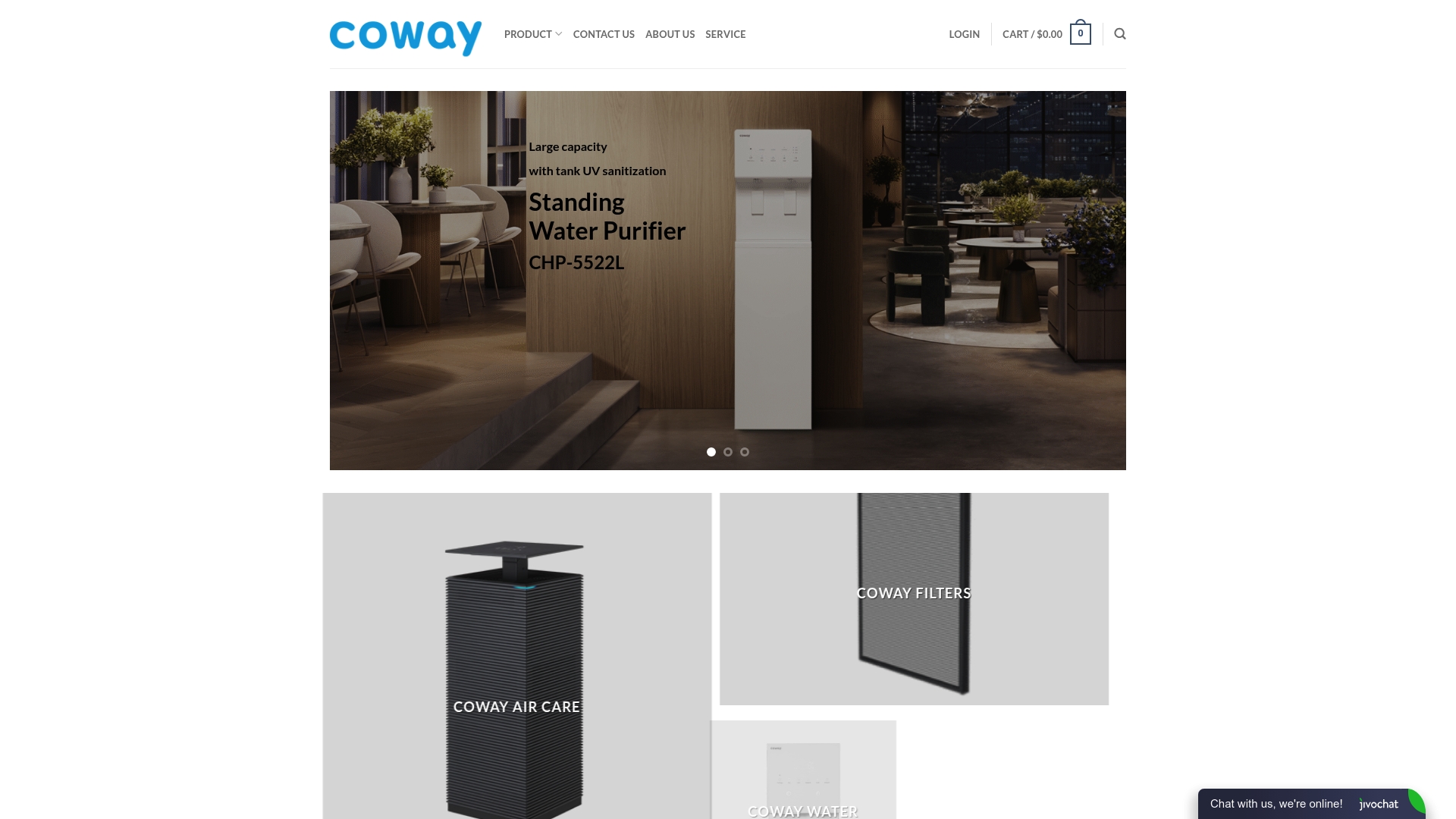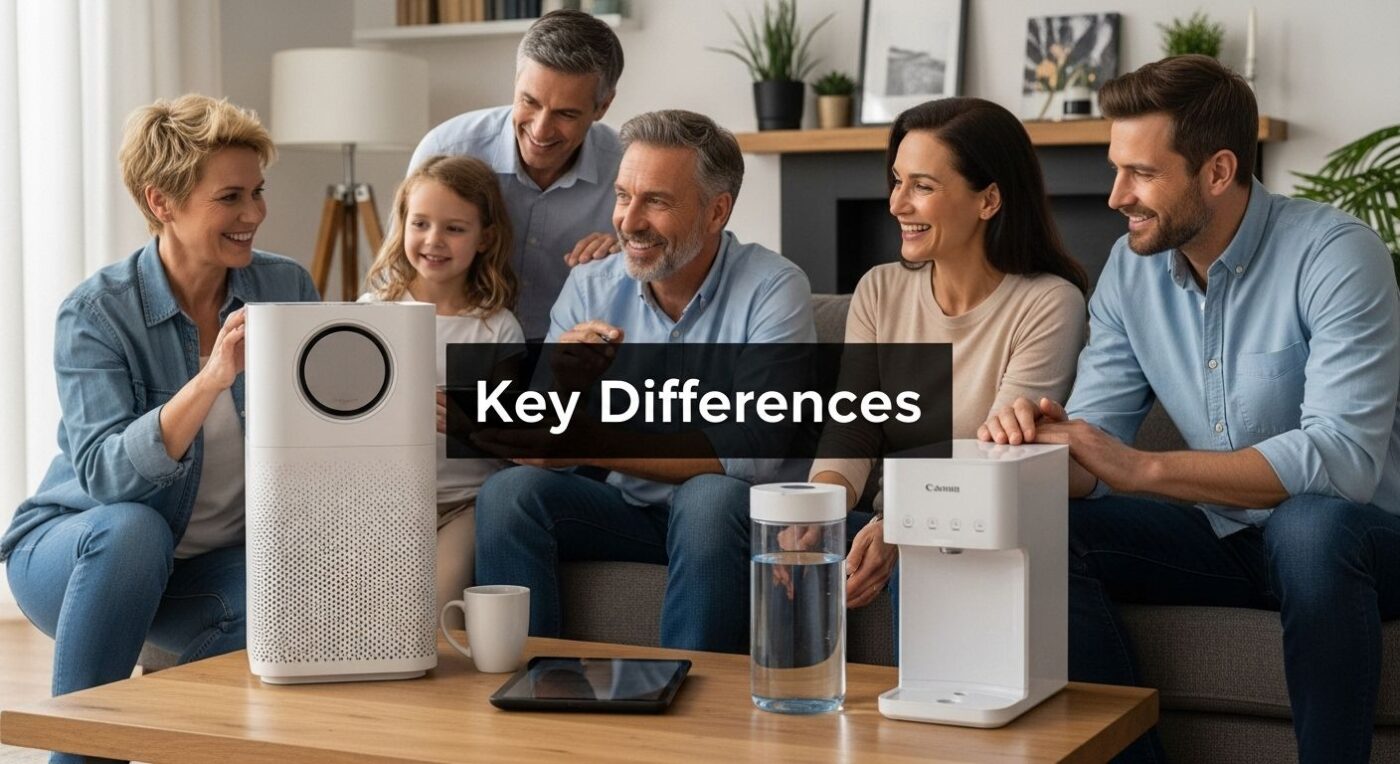Uncategorized
Understanding Air vs Water Purifiers: Key Differences Explained
Most people think opening a window or using tap water at home is good enough for healthy living. Yet indoor air can be up to five times more polluted than outdoor air and drinking water often holds invisible contaminants that go far beyond a funny taste or smell. What surprises many is that the technology quietly running inside air and water purifiers might be the single most powerful defense your health has right at home.
Table of Contents
- Defining Air And Water Purifiers: What They Are And Their Purpose
- The Importance Of Air And Water Quality: Why It Matters For Health
- How Air Purifiers Work: Technology Behind Clean Air Solutions
- How Water Purifiers Work: Mechanisms For Safe Drinking Water
- Comparing Air And Water Purifiers: Key Differences And Considerations
Quick Summary
| Takeaway | Explanation |
|---|---|
| Air purifiers improve indoor air quality. | They target and remove pollutants like dust, pollen, smoke, and microorganisms to create safer breathing environments. |
| Water purifiers ensure safe drinking water. | They eliminate harmful substances, including bacteria, viruses, and chemical pollutants, using various filtration technologies. |
| Contaminants impact health significantly. | Poor air and water quality can lead to respiratory and cardiovascular diseases, particularly affecting vulnerable populations. |
| Understand the technology behind purifiers. | Familiarize yourself with different purification methods, including HEPA for air and reverse osmosis for water, to make informed choices. |
| Maintain purifiers for optimal performance. | Regular maintenance, like filter changes, is essential to ensure continued effectiveness in removing harmful contaminants. |
Defining Air and Water Purifiers: What They Are and Their Purpose
In the quest for healthier living environments, air and water purifiers have become essential home wellness technologies. These devices play crucial roles in eliminating harmful contaminants from our immediate surroundings, protecting our health through advanced filtration mechanisms.
Understanding Air Purification Systems
Air purifiers are sophisticated devices engineered to improve indoor air quality by removing various pollutants. According to the U.S. Environmental Protection Agency, these systems target airborne particles that can negatively impact respiratory health.
They effectively capture and neutralize:
- Dust and microscopic debris
- Pollen and allergen particles
- Smoke and chemical vapors
- Bacteria and viral microorganisms
By circulating and filtering air through multiple layers of specialized filtration media, air purifiers create cleaner, safer breathing environments for homes and offices.
Water Purification Technologies
Water purifiers function differently from air purifiers, focusing on transforming potentially contaminated drinking water into safe, consumable liquid. Scientific research confirms that these systems are critical in removing microbial and chemical contaminants that could harm human health.
The primary goal of water purification is eliminating potentially dangerous substances like heavy metals, bacteria, viruses, and chemical pollutants. Different purification technologies such as reverse osmosis, UV sanitization, and activated carbon filtration work collaboratively to ensure water safety.
While their mechanisms differ, both air and water purifiers share a fundamental mission: protecting human health by creating safer, cleaner environmental conditions. Learn more about our comprehensive water purification guide to understand how these technologies safeguard your wellness.
The Importance of Air and Water Quality: Why It Matters for Health
Health is fundamentally connected to the quality of our immediate environment, with air and water serving as critical determinants of human wellness. Understanding how these essential elements impact our physiological systems reveals the profound relationship between environmental conditions and personal health.
The Silent Health Risks of Poor Environmental Quality
Contaminants in air and water represent invisible threats that can significantly undermine human health. Research from County Health Rankings indicates that poor environmental quality disproportionately affects vulnerable populations, including children, elderly individuals, and those with pre-existing health conditions.
The potential health consequences of compromised air and water quality include:
- Respiratory disorders and chronic lung diseases
- Cardiovascular complications
- Neurological impairments
- Weakened immune system responses
- Increased susceptibility to infectious diseases
Physiological Impact of Contamination
Air and water pollutants interact with human biological systems in complex ways. According to the Environmental Protection Agency, airborne pollutants can trigger immediate and long-term health complications. Microscopic particles, chemical compounds, and biological agents can penetrate our respiratory and digestive systems, causing inflammation, cellular damage, and systemic stress.
The human body continuously processes environmental inputs, making pure air and clean water fundamental to maintaining optimal health. Explore our comprehensive indoor air quality strategies to understand how you can proactively minimize environmental health risks.
How Air Purifiers Work: Technology Behind Clean Air Solutions
Air purifiers represent sophisticated technological solutions designed to transform indoor air quality through advanced filtration mechanisms. These devices leverage multiple scientific principles to capture, neutralize, and eliminate airborne contaminants that threaten human health.
Filtration Technologies and Particle Removal
According to the New York State Department of Health, air purifiers employ diverse technologies to clean indoor air. The primary filtration methods include:
- Mechanical filtration using HEPA filters
- Electrostatic precipitation
- Activated carbon adsorption
- Ultraviolet germicidal irradiation
- Photocatalytic oxidation
HEPA filters represent the gold standard in mechanical air purification, capable of capturing 99.97% of microscopic particles as small as 0.3 microns. These filters work through complex interception mechanisms, trapping pollutants within intricate fiber networks.
Advanced Purification Mechanisms
Modern air purifiers combine multiple technologies to achieve comprehensive air cleaning. The Environmental Protection Agency highlights that mechanical and electronic air cleaners use different strategies to remove particulate matter and gaseous pollutants.
Electronic air cleaners utilize electrostatic attraction, charging particles and capturing them on oppositely charged surfaces. Activated carbon filters specialize in removing odors, gases, and chemical vapors through advanced adsorption techniques. Ultraviolet light adds an additional layer of purification by deactivating microorganisms.
Learn more about maintaining optimal indoor air quality to ensure your air purification system continues performing at peak efficiency.
How Water Purifiers Work: Mechanisms for Safe Drinking Water
Water purification represents a complex scientific process designed to transform potentially contaminated water into safe, consumable liquid. By employing sophisticated technologies, water purifiers systematically eliminate harmful substances that could pose significant health risks to consumers.
Water Treatment Stages and Filtration Principles
According to the Centers for Disease Control and Prevention, water treatment involves multiple critical stages to ensure comprehensive contaminant removal. The primary water purification mechanisms include:
- Coagulation and flocculation
- Sedimentation
- Mechanical filtration
- Chemical disinfection
- Advanced membrane technologies
These stages work collaboratively to progressively remove increasingly smaller contaminants, transforming raw water into a clean, safe drinking source. Coagulation involves adding specialized chemicals that bind microscopic particles, creating larger clusters called flocs, which can be more easily filtered out of the water.
Advanced Purification Technologies
The Environmental Protection Agency highlights cutting-edge purification methods like reverse osmosis and nanofiltration. These advanced technologies utilize high-pressure membrane systems to remove an extensive range of contaminants, including dissolved solids, inorganic compounds, and potentially harmful synthetic chemicals.
Reverse osmosis represents a pinnacle of water purification technology, pushing water through ultra-fine semi-permeable membranes that block particles as small as individual ions. This process ensures that water is stripped of potentially dangerous microscopic contaminants, providing an unparalleled level of purification.
Explore our comprehensive guide to water purification methods to understand the intricate science behind creating safe drinking water.
Comparing Air and Water Purifiers: Key Differences and Considerations
While air and water purifiers share the fundamental goal of protecting human health by removing contaminants, their technological approaches, operational mechanisms, and target pollutants differ significantly.
 Understanding these distinctions helps consumers make informed decisions about environmental health protection.
Understanding these distinctions helps consumers make informed decisions about environmental health protection.
To help clarify the unique roles and mechanisms of air purifiers versus water purifiers, here is a side-by-side comparison of their key technologies and target contaminants.
| Feature | Air Purifier | Water Purifier |
|---|---|---|
| Primary Purpose | Improve indoor air quality | Ensure safe drinking water |
| Main Contaminants Targeted | Dust, pollen, smoke, bacteria, viruses | Bacteria, viruses, heavy metals, chemical pollutants |
| Common Filtration Technologies | HEPA, activated carbon, UV, electrostatic | Reverse osmosis, activated carbon, UV, flocculation |
| Typical Particle Size Addressed | 0.3 microns and larger (HEPA standard) | Down to individual ions (reverse osmosis) |
| Additional Purification Methods | Ultraviolet germicidal irradiation | Chemical disinfection, sedimentation |
| Application Area | Air in homes and offices | Tap water and drinking water supply |

Filtration Technologies and Target Contaminants
Princeton University’s Environmental Research highlights the nuanced differences in purification strategies. Water purifiers focus on eliminating microscopic biological and chemical contaminants through precise filtration methods, targeting organisms ranging from 5 microns (protozoa) to submicroscopic viral particles.
Key differences in contaminant targeting include:
- Water purifiers remove biological organisms and dissolved chemicals
- Air purifiers capture airborne particulate matter and allergens
- Water systems use pressure-based membrane technologies
- Air systems employ mechanical and electrostatic filtration
- Water purification often involves chemical disinfection
Operational Mechanisms and Performance Metrics
According to the University of Massachusetts Amherst, air purifiers primarily utilize HEPA filters capable of capturing 99.97% of particles as small as 0.3 microns. These systems focus on removing dust, pollen, mold spores, and bacteria from indoor environments.
Water purifiers, conversely, operate through more complex processes involving multiple filtration stages. Reverse osmosis and nanofiltration technologies push water through ultra-fine membranes, removing dissolved solids and microscopic contaminants with remarkable precision.
Discover comprehensive insights into maintaining your purification systems to ensure optimal performance and long-term health protection.
Take Control of Your Family’s Wellness with Coway Purifiers
Are you tired of worrying about what might be lurking in your air and water? This article highlighted how invisible contaminants can quietly disrupt your health, from triggering allergies to introducing dangerous bacteria into your daily routine. At Coway, we understand that choosing between air and water purifiers is only the first step. What you really want is continuous peace of mind and a healthier home for those you love. Learn more about our science-backed protection in our Uncategorized Archives.

Do not let health risks stay hidden in your living space. Explore the best of both worlds with Coway’s full line of air and water purifiers. Our solutions deliver proven filtration technology, easy installation, and ongoing support right to your door. Act now to upgrade your home with real clinical protection and see how quickly you can breathe and drink with total confidence.
Frequently Asked Questions
What is the primary difference between air purifiers and water purifiers?
Air purifiers are designed to remove airborne contaminants such as dust, pollen, and smoke from the indoor air, while water purifiers focus on eliminating harmful substances like bacteria, heavy metals, and chemical pollutants from drinking water.
How do air purifiers capture pollutants?
Air purifiers utilize various technologies, including HEPA filters, activated carbon adsorption, and ultraviolet light, to trap and neutralize airborne particles and pathogens effectively.
What kinds of contaminants can water purifiers remove?
Water purifiers can eliminate a wide range of contaminants, including bacteria, viruses, heavy metals, and chemical pollutants, using technologies like reverse osmosis, chemical disinfection, and mechanical filtration.
Can using both air and water purifiers improve overall health?
Yes, utilizing both air and water purifiers can significantly enhance your indoor environment by ensuring clean air and safe drinking water, reducing the risk of health issues associated with poor air and water quality.
Recommended
- What is Water Purification? Understanding Its Importance
- Understanding Why Change Purifier Filters Matters for Health
- What is Under-Sink Water Purifier? Understanding Its Importance
- 7 Effective Water Purification Methods for Your Home

